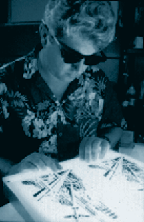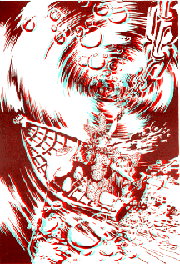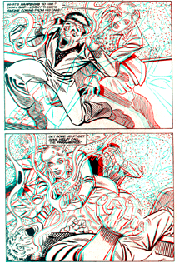

This question is very interesting because it raises some artistic issues about comic books that are important. Comic book writers, for example, might define the medium as a combination of words and pictures. Artists, however, might naturally stress the visual nature of comics. Alfred Hitchcock, whose very first movies were made as silent vehicles, emphasized that the story must be told visually even in a sound film. Comic books are essentially a visual medium and the experience of 3-D underscores this notion.
When we look at a 3-D comic book, we spend more time just gazing at the visual elements on the page and there is a very special delight in the optical discovery (optometrists call it stereofusion) of the many levels of depth that a 3-D comic page can present. The ideal art for 3-D treatment, therefore, is a full page splash or, better yet, a double-page spread.
These are some general guidelines for optimum 3-D graphics. Action, when it is depicted, should take place within a given depth of field within the page and not laterally Ieft-to-right as behind a theatrical proscenium. Events should happen at or away from the reader. Computer terminology designates this parameter as the z-axis which indicates depth as opposed to the x (width) or y(height) axes.
Point-of-View is implicit in a 3-D page. Thc reader interactively feels like a part of the action. Since thc action on a 3-D page is staged in virtual space which exists in relation to the reader, the art assumes a tangible quality and becomes much more tactile. Thc interactive relationship between the reader and thc apparently real imagery on the page is heightened with 3-D and, in effect, the reader becomes a character or presence in the story. One additional obvious proviso for 3-D comics is the use of foreshortening and heightened perspective. The two most obvious examples that come to mind are Jack Kirby and Neal Adams, both of whom create art which conveys 3-D even when it's not.
In selecting art for 3-D conversion I always have these general guidelines in mind. Most of what I have published has been pre-existing art, quite a bit of which has been in the public domain. In those instances where I worked with an artist to create new stories for 3-D, it was always to emphasize the visual nature of the dimensional medium.
Recently, I completed work with writer/artist Chuck Roblin on a 3-D comic titled Zori J's 3-D Bubble Bath. This work has been created specifically for 3-D publication. I proposed to Chuck that we create an entire book of full-page full-bleed splashes. And that is just what he did. In addition, there are many floating visual elements in the story in the form of bubbles. Chuck's art is in the realistic style of such comic art greats as Alex Raymond and Frank Frazetta and he designed many of the pages in the bubble book with deep focus, exagerrated perspective and many overlapping contours.

Full-bleed full-page splash created for 3-D
Marketing gimmickry aside, I elected to publish Zori J's Bubble Bath as both a 3-D and Black-and-White comic book. The 3-D version is entirely visual in nature. You have to pick up the Black-and-White version if you want to read captions and word balloons because they don't appear in the 3-D edition. Like the films of Alfred Hitchcock, the 3-D version of Zori J's Bubble Bath works just fine on a narrative level without any words.
Similarly, when Jack C. Harris was scripting 3-D Substance number 2, I instructed him to use fewer panels per page for Steve Ditko to illustrate. The Doctor Gaze back-up story in this book has several pages with only two panels. The page is opened up visually but there is a greater necessity on the part of the writer to use even more compression than usual in telling the story.

Fewer panels per page means greater
At this point it's appropriate to define just what it is a 3-D conversion artist does when processing art into dimension. 3-D conversion is an art form of rendering. Comics actually are a multilevel art form of rendering if you think about it. The penciller renders the script. The inker renders pencils and the colorist renders the finished art into chromatic hues for printing.
The 3-D artist renders dimension into the finished art. How is this done? By investing parallax into the art and making it appear as it would when seen from two slightly different vantage points simultaneously. So from the (monocular) provided art, a second eye view of the imagery is produced. Two slightly different (binocular) versions of the art then exist which are printed in either red or blue (complementary colors) on top of each other.
When viewed through the red and blue glasses the left and right eye views of the art are selected and channelled to the appropriate eye through color filtration. 3-D is then an art form for two eyes. This is not generally a problem. You need hearing to enjoy music and you need two (adequately functioning) eyes to experience 3-D.
In specific graphic terms, the art starts out as Black and White line art. I usually work at the same size as the original art (10 by 15 inch art area reduced to 60% size for printing as 6 by 9 inch art area in standard comic book size). Negative film at the finished size with register marks is delivered to the printer with indications for the special 3-D ink colors which are used during the press-run.
Though most 3-D comics are printed with 2-color 3-D it is possible to produce a full color 3-D image. Both use red and blue color selection to make the process work. This form of 3-D is called anaglyph and it is the most common form of 3-D in the world. Incidentally, once the left and right eye images have been produced they can be shown in other 3-D formats such as a Viewmaster reel or a 3-D slide show.
It generally takes me about 2 to 3 weeks to convert a 24 page comic to 3-D but the time can vary depending upon the complexity of the art and how many other additional projects are in the works. Having set forth some guidelines for optimum 3-D art let me now say that I have many times broken my own rules.
Some people may not think Krazy Kat a suitable property for 3-D treatment but I was intrigued by Herriman's use of empty space and evolving background imagery and so published a Krazy Kat 3-D book a few years ago. In one sense, I have to say that 3-D will improve or lend added appeal to any comic art regardless of its suitability for the dimensional medium. And many times I have elected to take existing art and stories by artists such as Wally Wood, Basil Wolverton, Bob Powell and others and render them into 3-D just for the sheer pleasure of seeing their great work in dimension.
So far, I have been very fortunate in having opportunities to work with the giants, artists such as Jack Kirby, Neal Adams, Dave Stevens, Milt Caniff, Will Eisner, Alex Raymond and many others in rendering their art into 3-D. For me this has been a dream come true. And, fortunately, I'm still dreaming.
First published July-August 1993 in CBG Price Guide
